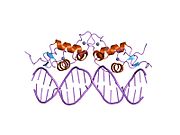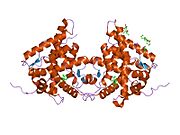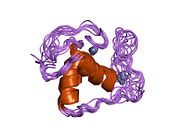Biology:Glucocorticoid receptor
 Generic protein structure example |
The glucocorticoid receptor (GR or GCR) also known as NR3C1 (nuclear receptor subfamily 3, group C, member 1) is the receptor to which cortisol and other glucocorticoids bind.
The GR is expressed in almost every cell in the body and regulates genes controlling the development, metabolism, and immune response. Because the receptor gene is expressed in several forms, it has many different (pleiotropic) effects in different parts of the body.
When glucocorticoids bind to GR, its primary mechanism of action is the regulation of gene transcription.[1][2] The unbound receptor resides in the cytosol of the cell. After the receptor is bound to glucocorticoid, the receptor-glucocorticoid complex can take either of two paths. The activated GR complex up-regulates the expression of anti-inflammatory proteins in the nucleus or represses the expression of pro-inflammatory proteins in the cytosol (by preventing the translocation of other transcription factors from the cytosol into the nucleus).
In humans, the GR protein is encoded by NR3C1 gene which is located on chromosome 5 (5q31).[3][4]
Structure
Like the other steroid receptors,[5] the glucocorticoid receptor is modular in structure[6] and contains the following domains (labeled A - F):
- A/B - N-terminal regulatory domain
- C - DNA-binding domain (DBD)
- D - hinge region
- E - ligand-binding domain (LBD)
- F - C-terminal domain
Ligand binding and response
In the absence of hormone, the glucocorticoid receptor (GR) resides in the cytosol complexed with a variety of proteins including heat shock protein 90 (hsp90), the heat shock protein 70 (hsp70) and the protein FKBP4 (FK506-binding protein 4).[7] The endogenous glucocorticoid hormone cortisol diffuses through the cell membrane into the cytoplasm and binds to the glucocorticoid receptor (GR) resulting in release of the heat shock proteins. The resulting activated form GR has two principal mechanisms of action, transactivation and transrepression,[8][9] described below.
Transactivation
A direct mechanism of action involves homodimerization of the receptor, translocation via active transport into the nucleus, and binding to specific DNA responsive elements activating gene transcription. This mechanism of action is referred to as transactivation. The biological response depends on the cell type.[citation needed]
Transrepression
In the absence of activated GR, other transcription factors such as NF-κB or AP-1 themselves are able to transactivate target genes.[10] However activated GR can complex with these other transcription factors and prevent them from binding their target genes and hence repress the expression of genes that are normally upregulated by NF-κB or AP-1. This indirect mechanism of action is referred to as transrepression.[citation needed] GR transrepression via NF-κB and AP-1 is restricted only to certain cell types, and is not considered the universal mechanism for IκBα repression. [11][12]
Clinical significance
The GR is abnormal in familial glucocorticoid resistance.[13]
In central nervous system structures, the glucocorticoid receptor is gaining interest as a novel representative of neuroendocrine integration, functioning as a major component of endocrine influence - specifically the stress response - upon the brain. The receptor is now implicated in both short and long-term adaptations seen in response to stressors and may be critical to the understanding of psychological disorders, including some or all subtypes of depression and post-traumatic stress disorder (PTSD).[14] Indeed, long-standing observations such as the mood dysregulations typical of Cushing's disease demonstrate the role of corticosteroids in regulating psychologic state; recent advances have demonstrated interactions with norepinephrine and serotonin at the neural level.[15][16]
In preeclampsia (a hypertensive disorder commonly occurring in pregnant women), the level of a miRNA sequence possibly targeting this protein is elevated in the blood of the mother. Rather, the placenta elevates the level of exosomes containing this miRNA, which can result in inhibition of translation of molecule. Clinical significance of this information is not yet clarified.[17]
Agonists and antagonists
Dexamethasone and other corticosteroids are agonists, while mifepristone and ketoconazole are antagonists of the GR. Anabolic steroids also prevent cortisol from binding to the glucocorticoid receptor.
Interactions
Glucocorticoid receptor has been shown to interact with:
- BAG1,[18][19]
- CEBPB,[20]
- CREBBP,[21]
- DAP3,[22]
- DAXX,[23]
- HSP90AA1,[22][24][25][26][27][28][29]
- HNRPU,[30]
- MED1,[31][32]
- MED14,[32]
- Mineralocorticoid receptor,[33]
- NRIP1,[31][34][35]
- NCOR1,[36][37]
- NCOA1,[31][38]
- NCOA2,[31][39]
- NCOA3,[31][40]
- POU2F1,[41][42]
- RANBP9,[43]
- RELA,[43][44][45]
- SMAD3,[46][47]
- SMARCD1,[40]
- SMARCA4[40][48]
- STAT3,[49][50]
- STAT5B,[51]
- Thioredoxin,[52]
- TRIM28,[53] and
- YWHAH.[54]
See also
- Membrane glucocorticoid receptor
- Selective glucocorticoid receptor agonist (SEGRA)
References
- ↑ "International Union of Pharmacology. LXV. The pharmacology and classification of the nuclear receptor superfamily: glucocorticoid, mineralocorticoid, progesterone, and androgen receptors". Pharmacological Reviews 58 (4): 782–797. December 2006. doi:10.1124/pr.58.4.9. PMID 17132855. [Free full text]
- ↑ "Antiinflammatory action of glucocorticoids--new mechanisms for old drugs". The New England Journal of Medicine 353 (16): 1711–1723. October 2005. doi:10.1056/NEJMra050541. PMID 16236742.
- ↑ "Primary structure and expression of a functional human glucocorticoid receptor cDNA". Nature 318 (6047): 635–641. December 1985. doi:10.1038/318635a0. PMID 2867473. Bibcode: 1985Natur.318..635H.
- ↑ "The glucocorticoid receptor gene is in 5q31-q32 [corrected]". Genomics 4 (4): 610–612. May 1989. doi:10.1016/0888-7543(89)90287-5. PMID 2744768.
- ↑ "The structure of the nuclear hormone receptors". Steroids 64 (5): 310–319. May 1999. doi:10.1016/S0039-128X(99)00014-8. PMID 10406480.
- ↑ "Gene regulation by the glucocorticoid receptor: structure:function relationship". The Journal of Steroid Biochemistry and Molecular Biology 94 (5): 383–394. April 2005. doi:10.1016/j.jsbmb.2004.12.046. PMID 15876404.
- ↑ "Chaperoning of glucocorticoid receptors". Molecular Chaperones in Health and Disease. Handbook of Experimental Pharmacology. 172. 2006. pp. 111–138. doi:10.1007/3-540-29717-0_5. ISBN 978-3-540-25875-9.
- ↑ "Glucocorticoids: exemplars of multi-tasking". British Journal of Pharmacology 147 (Supplement 1): S258–S268. January 2006. doi:10.1038/sj.bjp.0706456. PMID 16402112.
- ↑ "Effects of glucocorticoids on gene transcription". European Journal of Pharmacology 500 (1–3): 51–62. October 2004. doi:10.1016/j.ejphar.2004.07.011. PMID 15464020.
- ↑ "Physical association and functional antagonism between the p65 subunit of transcription factor NF-kappa B and the glucocorticoid receptor". Proceedings of the National Academy of Sciences of the United States of America 91 (2): 752–756. January 1994. doi:10.1073/pnas.91.2.752. PMID 8290595. Bibcode: 1994PNAS...91..752R.
- ↑ "The anti-inflammatory and immunosuppressive effects of glucocorticoids, recent developments and mechanistic insights". Molecular and Cellular Endocrinology 335 (1): 2–13. March 2011. doi:10.1016/j.mce.2010.04.005. PMID 20398732.
- ↑ "I kappaB alpha-independent downregulation of NF-kappaB activity by glucocorticoid receptor". The EMBO Journal 16 (15): 4698–4707. August 1997. doi:10.1093/emboj/16.15.4698. PMID 9303314.
- ↑ "Female pseudohermaphroditism caused by a novel homozygous missense mutation of the GR gene". The Journal of Clinical Endocrinology and Metabolism 87 (4): 1805–1809. April 2002. doi:10.1210/jcem.87.4.8379. PMID 11932321.
- ↑ "Neurobiology of depression: an integrated view of key findings". International Journal of Clinical Practice 61 (12): 2030–2040. December 2007. doi:10.1111/j.1742-1241.2007.01602.x. PMID 17944926. [Free full text]
- ↑ "5-HT(1A) receptor function in major depressive disorder". Progress in Neurobiology 88 (1): 17–31. May 2009. doi:10.1016/j.pneurobio.2009.01.009. PMID 19428959. [Free full text]
- ↑ "Methylation of NR3C1 is related to maternal PTSD, parenting stress and maternal medial prefrontal cortical activity in response to child separation among mothers with histories of violence exposure". Front Psychol 6: 690. 2015. doi:10.3389/fpsyg.2015.00690. PMID 26074844.
- ↑ "Placental Exosomes as Early Biomarker of Preeclampsia: Potential Role of Exosomal MicroRNAs Across Gestation". The Journal of Clinical Endocrinology and Metabolism 102 (9): 3182–3194. September 2017. doi:10.1210/jc.2017-00672. PMID 28531338.
- ↑ "RAP46 is a negative regulator of glucocorticoid receptor action and hormone-induced apoptosis". The Journal of Biological Chemistry 273 (23): 14620–14625. June 1998. doi:10.1074/jbc.273.23.14620. PMID 9603979.
- ↑ "Hsp70-RAP46 interaction in downregulation of DNA binding by glucocorticoid receptor". The EMBO Journal 19 (23): 6508–6516. December 2000. doi:10.1093/emboj/19.23.6508. PMID 11101523.
- ↑ "AF-2-dependent potentiation of CCAAT enhancer binding protein beta-mediated transcriptional activation by glucocorticoid receptor". Molecular Endocrinology 12 (11): 1749–1763. November 1998. doi:10.1210/mend.12.11.0191. PMID 9817600.
- ↑ "Role of important hydrophobic amino acids in the interaction between the glucocorticoid receptor tau 1-core activation domain and target factors". Biochemistry 37 (26): 9586–9594. June 1998. doi:10.1021/bi973029x. PMID 9649342.
- ↑ 22.0 22.1 "The pro-apoptotic protein death-associated protein 3 (DAP3) interacts with the glucocorticoid receptor and affects the receptor function". The Biochemical Journal. 349 349 (3): 885–893. August 2000. doi:10.1042/bj3490885. PMID 10903152.
- ↑ "Promyelocytic leukemia protein (PML) functions as a glucocorticoid receptor co-activator by sequestering Daxx to the PML oncogenic domains (PODs) to enhance its transactivation potential". The Journal of Biological Chemistry 278 (18): 15958–15965. May 2003. doi:10.1074/jbc.M300387200. PMID 12595526.
- ↑ "Delimitation of two regions in the 90-kDa heat shock protein (Hsp90) able to interact with the glucocorticosteroid receptor (GR)". Experimental Cell Research 247 (2): 461–474. March 1999. doi:10.1006/excr.1998.4375. PMID 10066374.
- ↑ "Nucleotide binding states of hsp70 and hsp90 during sequential steps in the process of glucocorticoid receptor.hsp90 heterocomplex assembly". The Journal of Biological Chemistry 277 (37): 33698–33703. September 2002. doi:10.1074/jbc.M204164200. PMID 12093808.
- ↑ "Evidence that the beta-isoform of the human glucocorticoid receptor does not act as a physiologically significant repressor". The Journal of Biological Chemistry 272 (42): 26659–26664. October 1997. doi:10.1074/jbc.272.42.26659. PMID 9334248.
- ↑ "The non-ligand binding beta-isoform of the human glucocorticoid receptor (hGR beta): tissue levels, mechanism of action, and potential physiologic role". Molecular Medicine 2 (5): 597–607. September 1996. doi:10.1007/BF03401643. PMID 8898375.
- ↑ "Agonist-free transformation of the glucocorticoid receptor in human B-lymphoma cells". The Journal of Steroid Biochemistry and Molecular Biology 57 (3–4): 239–249. February 1996. doi:10.1016/0960-0760(95)00271-5. PMID 8645634.
- ↑ "Use of the thiol-specific derivatizing agent N-iodoacetyl-3-[125I]iodotyrosine to demonstrate conformational differences between the unbound and hsp90-bound glucocorticoid receptor hormone binding domain". The Journal of Biological Chemistry 271 (15): 8831–8836. April 1996. doi:10.1074/jbc.271.15.8831. PMID 8621522.
- ↑ "The glucocorticoid receptor is associated with the RNA-binding nuclear matrix protein hnRNP U". The Journal of Biological Chemistry 272 (45): 28471–28478. November 1997. doi:10.1074/jbc.272.45.28471. PMID 9353307.
- ↑ 31.0 31.1 31.2 31.3 31.4 "Regulation of glucocorticoid receptor activity by 14--3-3-dependent intracellular relocalization of the corepressor RIP140". Molecular Endocrinology 15 (4): 501–511. April 2001. doi:10.1210/mend.15.4.0624. PMID 11266503.
- ↑ 32.0 32.1 "Differential regulation of glucocorticoid receptor transcriptional activation via AF-1-associated proteins". The EMBO Journal 18 (19): 5380–5388. October 1999. doi:10.1093/emboj/18.19.5380. PMID 10508170.
- ↑ "Glucocorticoid receptor homodimers and glucocorticoid-mineralocorticoid receptor heterodimers form in the cytoplasm through alternative dimerization interfaces". Molecular and Cellular Biology 21 (3): 781–793. February 2001. doi:10.1128/MCB.21.3.781-793.2001. PMID 11154266.
- ↑ "Regulation of subnuclear localization is associated with a mechanism for nuclear receptor corepression by RIP140". Molecular and Cellular Biology 23 (12): 4187–4198. June 2003. doi:10.1128/MCB.23.12.4187-4198.2003. PMID 12773562.
- ↑ "Receptor interacting protein RIP140 inhibits both positive and negative gene regulation by glucocorticoids". The Journal of Biological Chemistry 274 (25): 18121–18127. June 1999. doi:10.1074/jbc.274.25.18121. PMID 10364267.
- ↑ "Dissociation of steroid receptor coactivator 1 and nuclear receptor corepressor recruitment to the human glucocorticoid receptor by modification of the ligand-receptor interface: the role of tyrosine 735". Molecular Endocrinology 17 (5): 845–859. May 2003. doi:10.1210/me.2002-0320. PMID 12569182.
- ↑ "RU486-induced glucocorticoid receptor agonism is controlled by the receptor N terminus and by corepressor binding". The Journal of Biological Chemistry 277 (29): 26238–26243. July 2002. doi:10.1074/jbc.M203268200. PMID 12011091.
- ↑ "A point mutation of the AF2 transactivation domain of the glucocorticoid receptor disrupts its interaction with steroid receptor coactivator 1". The Journal of Biological Chemistry 277 (29): 26098–26102. July 2002. doi:10.1074/jbc.M204013200. PMID 12118039.
- ↑ "Crystal structure of the glucocorticoid receptor ligand binding domain reveals a novel mode of receptor dimerization and coactivator recognition". Cell 110 (1): 93–105. July 2002. doi:10.1016/S0092-8674(02)00817-6. PMID 12151000.
- ↑ 40.0 40.1 40.2 "BAF60a mediates critical interactions between nuclear receptors and the BRG1 chromatin-remodeling complex for transactivation". Molecular and Cellular Biology 23 (17): 6210–6220. September 2003. doi:10.1128/MCB.23.17.6210-6220.2003. PMID 12917342.
- ↑ "Selective binding of steroid hormone receptors to octamer transcription factors determines transcriptional synergism at the mouse mammary tumor virus promoter". The Journal of Biological Chemistry 274 (38): 26713–26719. September 1999. doi:10.1074/jbc.274.38.26713. PMID 10480874.
- ↑ "Recruitment of octamer transcription factors to DNA by glucocorticoid receptor". Molecular and Cellular Biology 18 (6): 3416–3430. June 1998. doi:10.1128/MCB.18.6.3416. PMID 9584182.
- ↑ 43.0 43.1 "RanBPM, a nuclear protein that interacts with and regulates transcriptional activity of androgen receptor and glucocorticoid receptor". The Journal of Biological Chemistry 277 (50): 48020–48027. December 2002. doi:10.1074/jbc.M209741200. PMID 12361945.
- ↑ "The glucocorticoid receptor inhibits NFkappaB by interfering with serine-2 phosphorylation of the RNA polymerase II carboxy-terminal domain". Genes & Development 14 (18): 2314–2329. September 2000. doi:10.1101/gad.827900. PMID 10995388.
- ↑ "Negative cross-talk between RelA and the glucocorticoid receptor: a possible mechanism for the antiinflammatory action of glucocorticoids". Molecular Endocrinology 9 (4): 401–412. April 1995. doi:10.1210/mend.9.4.7659084. PMID 7659084.
- ↑ "Identification of glucocorticoid receptor domains involved in transrepression of transforming growth factor-beta action". The Journal of Biological Chemistry 278 (43): 41779–41788. October 2003. doi:10.1074/jbc.M305350200. PMID 12902338.
- ↑ "Glucocorticoid receptor inhibits transforming growth factor-beta signaling by directly targeting the transcriptional activation function of Smad3". Proceedings of the National Academy of Sciences of the United States of America 96 (21): 11776–11781. October 1999. doi:10.1073/pnas.96.21.11776. PMID 10518526. Bibcode: 1999PNAS...9611776S.
- ↑ "Recruitment of the SWI-SNF chromatin remodeling complex as a mechanism of gene activation by the glucocorticoid receptor tau1 activation domain". Molecular and Cellular Biology 20 (6): 2004–2013. March 2000. doi:10.1128/MCB.20.6.2004-2013.2000. PMID 10688647.
- ↑ "STAT3-dependent enhanceosome assembly and disassembly: synergy with GR for full transcriptional increase of the alpha 2-macroglobulin gene". Genes & Development 17 (20): 2564–2577. October 2003. doi:10.1101/gad.1135003. PMID 14522952.
- ↑ "STAT3 acts as a co-activator of glucocorticoid receptor signaling". The Journal of Biological Chemistry 272 (49): 30607–30610. December 1997. doi:10.1074/jbc.272.49.30607. PMID 9388192.
- ↑ "Functional interactions between Stat5 and the glucocorticoid receptor". Nature 383 (6602): 726–728. October 1996. doi:10.1038/383726a0. PMID 8878484. Bibcode: 1996Natur.383..726S. https://hal-univ-tours.archives-ouvertes.fr/hal-02427426/file/Functional%20interactions%20between%20StatS%20and%20GR.pdf.
- ↑ "Direct association with thioredoxin allows redox regulation of glucocorticoid receptor function". The Journal of Biological Chemistry 274 (5): 3182–3188. January 1999. doi:10.1074/jbc.274.5.3182. PMID 9915858.
- ↑ "Coactivator TIF1beta interacts with transcription factor C/EBPbeta and glucocorticoid receptor to induce alpha1-acid glycoprotein gene expression". Molecular and Cellular Biology 18 (10): 5880–5887. October 1998. doi:10.1128/mcb.18.10.5880. PMID 9742105.
- ↑ "Interaction of the ligand-activated glucocorticoid receptor with the 14-3-3 eta protein". The Journal of Biological Chemistry 272 (13): 8153–8156. March 1997. doi:10.1074/jbc.272.13.8153. PMID 9079630.
Further reading
- "Molecular mechanisms of corticosteroid actions". Monaldi Archives for Chest Disease = Archivio Monaldi per le Malattie del Torace 55 (3): 256–266. June 2000. PMID 10948677.
- "Mechanisms of corticosteroid resistance in rheumatoid arthritis: a putative role for the corticosteroid receptor beta isoform". Annals of the New York Academy of Sciences 966 (1): 39–48. June 2002. doi:10.1111/j.1749-6632.2002.tb04200.x. PMID 12114257. Bibcode: 2002NYASA.966...39C.
- "Involvement of the glucocorticoid receptor in the pathogenesis of rheumatoid arthritis". Annals of the New York Academy of Sciences 966 (1): 491–495. June 2002. doi:10.1111/j.1749-6632.2002.tb04252.x. PMID 12114309. Bibcode: 2002NYASA.966..491N.
- "The glucocorticoid receptor: coding a diversity of proteins and responses through a single gene". Molecular Endocrinology 16 (8): 1719–1726. August 2002. doi:10.1210/me.2002-0106. PMID 12145329.
- "[Response to glucocorticoid treatment in asthma. The role of alpha and beta isoforms of the glucocorticoid receptor]". Archivos de Bronconeumologia 38 (9): 436–440. September 2002. doi:10.1016/S0300-2896(02)75258-7. PMID 12237016.
- "Variations of the human glucocorticoid receptor gene (NR3C1): pathological and in vitro mutations and polymorphisms". Human Mutation 21 (6): 557–568. June 2003. doi:10.1002/humu.10213. PMID 12754700.
- "Partner molecules of accessory protein Vpr of the human immunodeficiency virus type 1". DNA and Cell Biology 23 (4): 193–205. April 2004. doi:10.1089/104454904773819789. PMID 15142377. https://zenodo.org/record/1235217.
- "The origin and functions of multiple human glucocorticoid receptor isoforms". Annals of the New York Academy of Sciences 1024 (1): 102–123. June 2004. doi:10.1196/annals.1321.008. PMID 15265776. Bibcode: 2004NYASA1024..102L. https://zenodo.org/record/1235886.
- "Human immunodeficiency virus type-1 accessory protein Vpr: a causative agent of the AIDS-related insulin resistance/lipodystrophy syndrome?". Annals of the New York Academy of Sciences 1024 (1): 153–167. June 2004. doi:10.1196/annals.1321.013. PMID 15265780. Bibcode: 2004NYASA1024..153K. https://zenodo.org/record/1235880.
- "The role of Vpr in HIV-1 pathogenesis". Current HIV Research 3 (1): 43–51. January 2005. doi:10.2174/1570162052772988. PMID 15638722.
- "The Vpr protein from HIV-1: distinct roles along the viral life cycle". Retrovirology 2 (1): 11. February 2005. doi:10.1186/1742-4690-2-11. PMID 15725353.
- "Human immunodeficiency virus type 1 (HIV-1) Vpr-regulated cell death: insights into mechanism". Cell Death and Differentiation 12 (Suppl 1): 962–970. August 2005. doi:10.1038/sj.cdd.4401583. PMID 15832179.
- "The human glucocorticoid receptor: one gene, multiple proteins and diverse responses". Steroids 70 (5–7): 407–417. 2005. doi:10.1016/j.steroids.2005.02.006. PMID 15862824. https://zenodo.org/record/1259367.
- "Intracellular glucocorticoid signaling: a formerly simple system turns stochastic". Science's STKE 2005 (304): pe48. October 2005. doi:10.1126/stke.3042005pe48. PMID 16204701.
- "[Balloon probe for the removal of emboli and thrombi]". Meditsinskaya Tekhnika (3): 42–43. 1975. PMID 1152650.
- "Glucocorticoid regulation of alkaline phosphatase, osteocalcin, and proto-oncogenes in normal human osteoblast-like cells". Journal of Cellular Biochemistry 50 (4): 411–424. December 1992. doi:10.1002/jcb.240500410. PMID 1469072.
- "Association of the transformed glucocorticoid receptor with a cytoskeletal protein complex". The Journal of Steroid Biochemistry and Molecular Biology 41 (3–8): 719–721. March 1992. doi:10.1016/0960-0760(92)90411-B. PMID 1562545.
- "Hormonal regulation of the nuclear localization signals of the human glucocorticosteroid receptor". Experimental Cell Research 201 (1): 99–108. July 1992. doi:10.1016/0014-4827(92)90352-9. PMID 1612132.
- "Point mutation causing a single amino acid substitution in the hormone binding domain of the glucocorticoid receptor in familial glucocorticoid resistance". The Journal of Clinical Investigation 87 (2): 680–686. February 1991. doi:10.1172/JCI115046. PMID 1704018.
- "The genomic structure of the human glucocorticoid receptor". The Journal of Biological Chemistry 266 (11): 7182–7188. April 1991. doi:10.1016/S0021-9258(20)89627-6. PMID 1707881.
External links
- Human Protein Reference Database
- Glucocorticoid+receptors at the US National Library of Medicine Medical Subject Headings (MeSH)
- FactorBook GR
- Overview of all the structural information available in the PDB for UniProt: P04150 (Glucocorticoid receptor) at the PDBe-KB.
 |










